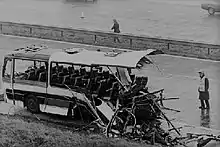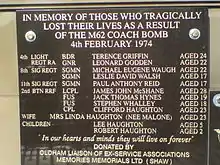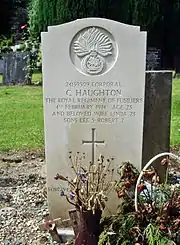M62 coach bombing
The M62 coach bombing occurred on 4 February 1974 on the M62 motorway in northern England, when a 25 pound (11 kg) Provisional Irish Republican Army (IRA) bomb hidden inside the luggage locker of a coach carrying off-duty British Armed Forces personnel and their family members exploded, killing twelve people (nine soldiers and three civilians) and injuring thirty-eight others.[3]
| M62 coach bombing | |
|---|---|
| Part of the Troubles | |
 Aftermath of the M62 coach bombing | |
| Location | Near Oakwell Hall, between junctions 26 and 27, M62 motorway, West Riding of Yorkshire, England |
| Coordinates | 53°44′36″N 1°40′07″W |
| Date | 4 February 1974 c. 00:10[1] |
Attack type | Time bomb |
| Deaths | 12 (9 soldiers, 3 civilians)[2] |
| Injured | 38 (soldiers and civilians) |
| Perpetrator | Provisional IRA |
Ten days after the bombing, 25-year-old Judith Ward was arrested in Liverpool while waiting to board a ferry to Ireland.[4] She was later convicted of the M62 coach bombing and two other separate attacks and remained incarcerated until her conviction was quashed by the Court of Appeal.
Ward was released from prison in May 1992, having served 18 years of a 30-year term of imprisonment, with the Court hearing Government forensic scientists had withheld information from her defence counsel indicating her innocence at her 1974 trial.[5] As such, her conviction was judged as wrongful.[6]
The M62 coach bomb has been described as "one of the IRA's worst mainland terror attacks" and remains one of the deadliest mainland acts of the Troubles.[7]
The bombing
The bombed coach had been specially commissioned to carry British Army and Royal Air Force personnel—on leave with their families—to and from bases at Catterick and Darlington during a period of railway strike action.[8] The vehicle itself had departed from Manchester and was making good progress along the motorway, travelling at approximately 60 mph (100 km/h). Shortly after midnight, as most of those aboard were sleeping and when the bus was travelling between junctions 26 and 27 of the M62 the bomb exploded. The blast—which could be heard several miles away—reduced the rear of coach to a "tangle of twisted metal" and threw individuals and severed limbs up to 250 yards (230 m) upon and around the motorway.[9] The coach itself travelled for more than 200 yards (180 m) before the driver, Roland Handley (himself injured by flying glass), was able to steer the coach to a halt upon the hard shoulder.[10][n 1]
One surviving soldier later described him being blown through the emergency doors of the coach, only to find himself upon the ground viewing a "mangled wreck". This individual later assisted a young girl aged approximately 17 with injured legs whom he found lying approximately 200 yards (180 m) "back up the [motorway]". According to this individual, the girl had repeatedly hysterically screamed: "My God! The floor just opened up and I fell through!" as he provided medical assistance.[12]
The explosion killed eleven people outright and wounded over thirty others,[13] one of whom died four days later. Amongst the dead were nine soldiers – two from the Royal Artillery, three from the Royal Corps of Signals and four from the 2nd Battalion Royal Regiment of Fusiliers. One of the latter was Corporal Clifford Haughton, whose entire family, consisting of his wife Linda and his sons Lee, aged 5, and Robert, aged 2, were also killed.[n 2] Numerous others suffered severe injuries, including a six-year-old boy, who was badly burned.[9]
The entrance hall of the westbound section of the Hartshead Moor service area was used as a first aid station for those wounded in the blast.[15] A memorial to those who were killed was later erected at this location.[16] Following a campaign by relatives of the dead, a larger memorial was later erected, set some yards away from the entrance hall.[17][18][19] The site, situated behind four flag poles, includes an English oak tree, a memorial stone, a memorial plaque and a raised marble tablet inscribed with the names of those who died. A memorial plaque engraved with the names of the casualties was also unveiled in Oldham in 2010.[20]
Reaction
Reactions in Britain were furious, with senior politicians from all parties calling for immediate action against the perpetrators and the IRA in general.[21] The British media were equally condemnatory; according to The Guardian, it was "the worst IRA outrage on the British mainland" at that time,[22] whilst the BBC described the bombing as "one of the IRA's worst mainland terror attacks".[16] Irish newspaper The Sunday Business Post later described it as the "worst" of the "awful atrocities perpetrated by the IRA" during this period.[23]
Following the bombing, the British public and politicians from all three major parties called for "swift justice".[21]
IRA Army Council response
Although a police spokesman emphasised investigators were keeping an "open mind" as to the cause of the explosion, in the days immediately following the bombing, suspicion quickly fell upon the IRA, which had extended its campaign to England the previous year.[24]
IRA Army Council member Dáithí Ó Conaill was challenged over the bombing and the deaths of civilians during an interview. Ó Conaill replied that the coach was selected as a target because IRA intelligence indicated that the vehicle was carrying military personnel only.[25]

The attack's most lasting consequence was the adoption of much stricter 'anti-terrorism' laws in Great Britain and Northern Ireland, allowing police to hold those 'suspected of terrorism' for up to seven days without charge, and to deport those 'suspected of terrorism' in Britain or the Republic of Ireland to Northern Ireland to face trial, where special courts judged with separate rules applying to 'terrorism' suspects.[26]
Investigation
Prosecution of Judith Ward
The ensuing police investigation, led by Detective Chief Superintendent George Oldfield would prove to be rushed, careless and ultimately forged, resulting in the arrest of the mentally ill Judith Ward (born 10 January 1949). Ward claimed to have conducted a string of bombings in Britain in 1973 and 1974 and to have married and had a baby with two separate IRA members.[27]
Despite irrefutable proof that Ward had been in Chippenham, Wiltshire at the time of the bombing,[28] her subsequent retraction of her claims to have conducted several bombings throughout the previous year,[29] the lack of any corroborating evidence against Ward, and serious gaps in her testimony – which was frequently rambling, incoherent and "improbable"[30] – she was wrongfully convicted in November 1974.[31]
IRA statement
Shortly after Ward's conviction of the M62 coach bombing, the Irish Republican Publicity Bureau issued a formal statement:
Miss Ward was not a member of Óglaigh na hÉireann and was not used in any capacity by the organisation. She had nothing to do what-so-ever with the military coach bomb (on 4 February 1974), the bombing of Euston Station and the attack on Latimer Military College. Those acts were authorised operations carried out by units of the Irish Republican Army.[32]
Release
The case against Ward was almost completely based on inaccurate scientific evidence using the Griess test and deliberate manipulation of her confession by some members of the investigating team.[21] The case was similar to those of the Guildford Four, the Birmingham Six and the Maguire Seven, which occurred at the same time and involved similar forged confessions and inaccurate scientific analysis. Ward was finally released in May 1992, when three Court of Appeal judges held unanimously that her conviction was "a grave miscarriage of justice", and that it had been "secured by ambush".[33]
Gallery
 Memorial plaque at Hartshead Moor services
Memorial plaque at Hartshead Moor services Second memorial at Hartshead Moor services
Second memorial at Hartshead Moor services Haughton family grave, Blackley Cemetery
Haughton family grave, Blackley Cemetery
See also
Notes
- Handley's actions in steering the bombed coach to safety were later commended. He died at the age of 76 in January 2012.[11]
- The Haughton family are buried in Blackley Cemetery, Manchester.[14]
References
- "Memorial Service Remembers the Victims of M62 Coach Bombing 45 Years On". The Halifax Courier. 6 February 2019. Retrieved 4 February 2021.
- Sutton, Malcolm. "CAIN: Sutton Index of Deaths". cain.ulst.ac.uk. Retrieved 17 June 2017.
- Also described as a 50lb bomb in Lost Lives 2007 ed, p. 434, ISBN 978-1-84018-504-1
- "IRA Groupie Jailed for Coach Bomb Sought Folklore Fame". The Guardian. 22 March 1991. Retrieved 4 February 2021.
- "Regina v Ward (Judith): CACD 15 Jul 1992". swarb.co.uk. 25 November 2020. Retrieved 4 February 2021.
- "'There are Times When I Wish I Was Back in Jail'". The Independent. 1 October 1996. Retrieved 4 February 2021.
- "Tragedy On The M62". BBC News. 17 April 2008. Retrieved 4 February 2021.
- "M62 IRA Coach Bombing: True Love Story, But Linda and Cliff Died With Their Sons in Attack". Belfast Newsletter. 7 February 2019. Retrieved 5 February 2021.
- p. 240, Williams & Head
- "Hero Driver of M62 Coach Bombing Honoured with Memorial". Manchester Evening News. 31 January 2013. Retrieved 31 May 2015.
- "Hero Driver of M62 Coach Bombing Honoured With Memorial". Manchester Evening News. 31 January 2013. Retrieved 31 May 2015.
- Lost Lives: The Stories of the Men, Women and Children Who Died as a Result of the Northern Ireland Troubles ISBN 978-1-840-18504-1 p. 435
- "Tributes Paid to M62 Coach Bomb Victims 40 Years On". The Huddersfield Daily Examiner. 3 February 2014. Retrieved 4 February 2017.
- "Corporal Clifford Haughton" (PDF). nivets.org.uk. Retrieved 5 February 2021.
- "M62 Coach Bomb Survivors Sought For New Memorial". Oldham Evening Chronicle. 19 January 2009. Retrieved 5 February 2021.
- "Tragedy On The M62". BBC Bradford and West Yorkshire. Retrieved 28 February 2007.
- "New Tribute to Bomb's Victims; M62 Atrocity Recalled After 35 Years". Huddersfield Daily Examiner. 2008.
- ""Plans to Move Bomb Blast Memorial". BBC News. 29 July 2008.
- "New Memorial Unveiled to Bus Bomb Victims". Bradford Telegraph and Argus. 4 February 2009. Retrieved 31 May 2015.
- Cooper, Louise (1 February 2015). "M62 Coach Bombing Victims Remembered 41 Years On At Memorial Service". Huddersfield Examiner. Retrieved 21 May 2015.
- p. 241, Williams & Head
- "Miscarriages of Justice". Guardian Unlimited. Retrieved 28 February 2007.
- "Her Body Simply Disintegrated in Our Arms". Sunday Business Post. 14 December 2003. Archived from the original on 26 September 2007. Retrieved 28 February 2007.
- "1974: Soldiers and Children Killed in Coach Bombing". BBC News. 4 February 2005. Retrieved 3 February 2021.
- p. 150, McGladdery
- p. 245 Williams & Head
- Kennedy, Helena (31 March 2011). Eve Was Framed: Women and British Justice. Random House. ISBN 9781446468340. Retrieved 17 June 2017 – via Google Books.
- May, Paul. "'Buried Alive': The Case of Judy Ward 25 Years On". hejusticegap.com. Retrieved 4 February 2021.
- "1974: Soldiers and Children Killed in Coach Bombing". BBC On This Day. Retrieved 27 February 2007.
- In the words of her barrister Andrew Rankin QC, p. 242 Williams & Head
- "40th Anniversary of M62 Coach Bomb Tragedy". ITV. 2 February 2014. Retrieved 5 February 2021.
- p. 89 McGladdery,
- p. 244 Williams & Head
Cited works and further reading
- Chalk, Peter (2012). The Encyclopedia of Terrorism – Volume 1. BC-CLIO. ISBN 978-0-313-30895-6.
- Davis, Jennifer (2013). Wrongly Convicted: Miscarriages of Justice. RW Press Ltd. ISBN 978-1-909-28440-1.
- Geraghty, Tony (1998). The Irish War: The Hidden Conflict Between the IRA and British Intelligence. Harper Collins. ISBN 978-0-006-38674-2.
- McGladdery, Gary (2006). The Provisional IRA in England: The Bombing Campaign 1973–1997. Irish Academic Press. ISBN 978-0-7165-3374-0.
- Moysey, Steve (2019). The Road to Balcombe Street: The IRA Reign of Terror in London. Taylor & Francis Publishing. ISBN 978-1-136-74858-5.
- Ward, Judith (1993). Ambushed: My Story. Vermilion Press. ISBN 978-0-091-77820-0.
- Williams, Anne; Head, Vivian (2006). Terror Attacks: The Violent Expression of Desperation – IRA Coach Bomb. Futura. ISBN 0-7088-0783-6.
External links
- UK Cases: Judith Theresa Ward: Details of Ward's background and her subsequent confession to police
- BBC news article pertaining to the M62 coach bombing
- 2019 Yorkshire Post article focusing upon the M62 coach bombing and subsequent conviction of Judith Ward